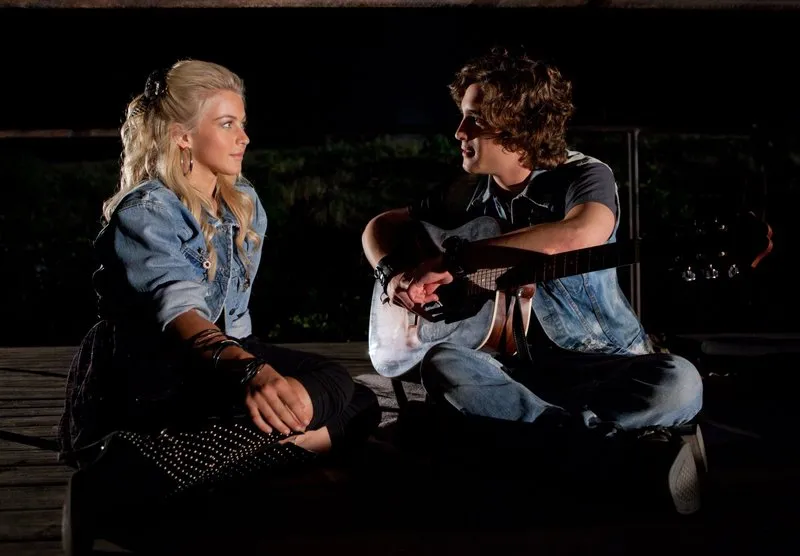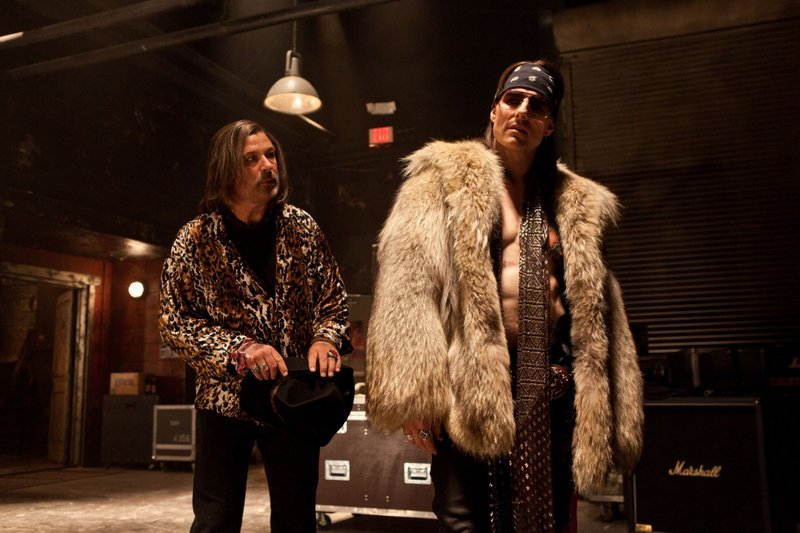In the mid-1980s, Hollywood’s Sunset Strip was the world’s capital for sweaty nightclubs, drug-fueled parties and a brand of sexually aggressive and insidiously catchy rock ‘n’ roll. An eyesore on Reagan’s America, the Strip was a mile-and-a-half stretch of sin, vice and other family-unfriendly values.
Obviously, it had to become a musical.
That happened in the mid-2000s, when producer Scott Prisand helped launch “Rock of Ages,” a stage production set against the legendary boulevard. The androgynous but muscular rock once mocked as “hair metal” — now a staple of classic-rock radio — served as its soundtrack, from Journey’s “Don’t Stop Believin’ ” to Poison’s “Every Rose Has Its Thorn.” After an Off-Broadway run, the musical’s combination of rebel yells and safe nostalgia proved irresistible, and in 2009 “Rock of Ages” became a Broadway smash.
“It was perfect for people who were 40, 45 years old, the people who have families and careers — it takes you back to a fun time,” says Prisand, now based in Los Angeles. “We felt that this audience didn’t have much on Broadway that was speaking directly to them. Obviously, a song like ‘Don’t Stop Believin’ — you hear the first few bars and people go nuts.”
On Friday, “Rock of Ages” made its debut as a Hollywood movie. Set in 1987, it stars Julianne Hough and Diego Boneta as wannabe rockers and Tom Cruise as megastar Stacee Jaxx. Alec Baldwin and Russell Brand are the managers of the raunchy Bourbon Room nightclub, Paul Giamatti plays a greedy band manager and Malin Akerman appears as a gutsy reporter from Rolling Stone. Justin Theroux (“Tropic Thunder”) co-wrote the script; Adam Shankman (“Hairspray”) directs.
Anyone watching the film can play Name That Tune, and perhaps even Spot the Anachronism (when did Extreme’s “More Than Words” come out? Answer: 1991). But for those who don’t know the real-life history of the Sunset Strip, here’s your guide to the people and landmarks in “Rock of Ages.”
THE BOURBON ROOM: The sweaty club at the center of the movie is clearly modeled on the legendary Whisky a Go Go. During the 1960s, the Whisky was a second home to The Doors, The Byrds and Van Morrison’s Them; in the ’70s, its shows ran the gamut from metal (Motley Crue, Van Halen) to punk and new wave (The Germs, Blondie, The Police). The fictional Bourbon Room is owned by the financially floundering Dennis Dupree (Alec Baldwin), though the Whisky’s real co-founder, Elmer Valentine, also co-owned other local hot spots. His nearby Roxy Theatre, another famously rowdy venue (reportedly where John Belushi began his final bender in 1982) may also be an inspiration.
STACEE JAXX: A minor character in the play, Jaxx is now a major character played by Cruise. The singer of the fictional band Arsenal, Jaxx is an irresistible sex god, but also a cautionary tale. He totes a bottle of Scotch (much like Guns N’ Roses guitarist Slash once did), but he talks like a spaced-out Jim Morrison (“I ask you, have these people even met themselves?”). Director Shankman says he envisioned the character as the tragic product of a famously self-indulgent era. “In that period, there were no consequences,” says Shankman, who grew up in Los Angeles. “For straight people, there was no AIDS. There were mountains of drugs and no rehab. You threw mattresses and television sets out of the hotel window and people would just cheer. That was the ’80s.”
SHERRIE CHRISTIAN: Played by Julianne Hough (“Footloose”), this fictional heroine flees Kansas for Los Angeles in the hopes of becoming a singer. (Her name combines Journey’s single “Oh Sherrie” and Night Ranger’s power ballad “Sister Christian,” both released in 1984). Hough bears some similarities to her role — she left Utah for Los Angeles at 18 and became a country singer — but needed a physical makeover to play the part. “I did a whole different kind of workout regimen to make my body look more ’80s, more curvaceous,” Hough says. “I ran but didn’t do as much cardio, and I lifted more weights and did more squats. My booty was a lot bigger! And so was the top half of my body.”
DREW BOLEY: The role of the lowly bartender with rock-star dreams is played by Diego Boneta, a Mexican pop singer and soap-opera actor all but unknown in America. “It was a six-week audition process, totally nerve-racking — acting, singing, recording,” says Boneta, who is fluent in English and Spanish. “Adam Shankman gave me a call and said, ‘Sometimes these things work out and sometimes they don’t. But this time, it worked!’ I wanted to kill him and hug him at the same time.” Constantine Maroulis, the season 4 “American Idol” finalist who played Drew on Broadway, appears briefly in the movie as a cheesy record executive.
BEN FRANK’S: In the 1980s, Los Angeles was still a treasure trove of post-World War II coffee shops with atomic architecture and Cadillac-style detailing. Along with the so-called Rock ‘n’ Roll Denny’s at 7373 Sunset, the now-defunct Ben Frank’s was an after-hours must for musicians, groupies and scenesters. Look quickly for its distinctive sign (orange lettering on a white background) around the time Drew gets his big break. Shankman credits L.A.-raised production designer Jon Hutman for including it.
PATRICIA WHITMORE: Played by Catherine Zeta-Jones, Whitmore is the wife of the Los Angeles mayor (Bryan Cranston) and an ambitious politico in her own right who wants to ban rock music and “take Satan off the streets.” To create the character, “I went back to the source, when Tipper Gore was running around telling people music was filth and putting warning labels on records,” says Theroux. “It seemed a shame not to capitalize on the reality of the era.”
JUSTICE: Mary J. Blige plays the mother-hen manager of the fictional nudie bar the Venus Club, where a down-and-out Sherrie waits tables. Blige’s musical numbers include Pat Benatar’s 1982 hit “Shadows of the Night” and Quarterflash’s “Harden My Heart,” from 1981. “I knew that it required more than just singing,” Blige says. “It required singing – really belting it out and being inspired by the words, and the emotions that came through the words. I had to deliver.”
TOWER RECORDS: Before it became uncool to shop at corporate record stores, this one (where Sherrie and Drew have one of their first dates) was the nation’s coolest. Its hip staff could make or break singles, its customers were celebrities (Elton John kept an account there) and it was sometimes as rowdy as the nearby nightclubs (a 1988 appearance by David Lee Roth clogged traffic along the Boulevard). When Tower Records went belly-up in 2006, staffers at the Sunset store posted an R.E.M. lyric on the marquee: “The End of the World As We Know It.”
THE ROCKERS: Near the film’s end, as protesters and rock fans square off in the streets, keep an eye on the rock side. In the crowd you’ll see Night Ranger guitarist Joel Hoekstra, Extreme guitarist Nuno Bettencourt, Skid Row frontman Sebastian Bach, REO Speedwagon singer Kevin Cronin and — why not? — Debbie Gibson.
Send questions/comments to the editors.




Success. Please wait for the page to reload. If the page does not reload within 5 seconds, please refresh the page.
Enter your email and password to access comments.
Hi, to comment on stories you must . This profile is in addition to your subscription and website login.
Already have a commenting profile? .
Invalid username/password.
Please check your email to confirm and complete your registration.
Only subscribers are eligible to post comments. Please subscribe or login first for digital access. Here’s why.
Use the form below to reset your password. When you've submitted your account email, we will send an email with a reset code.